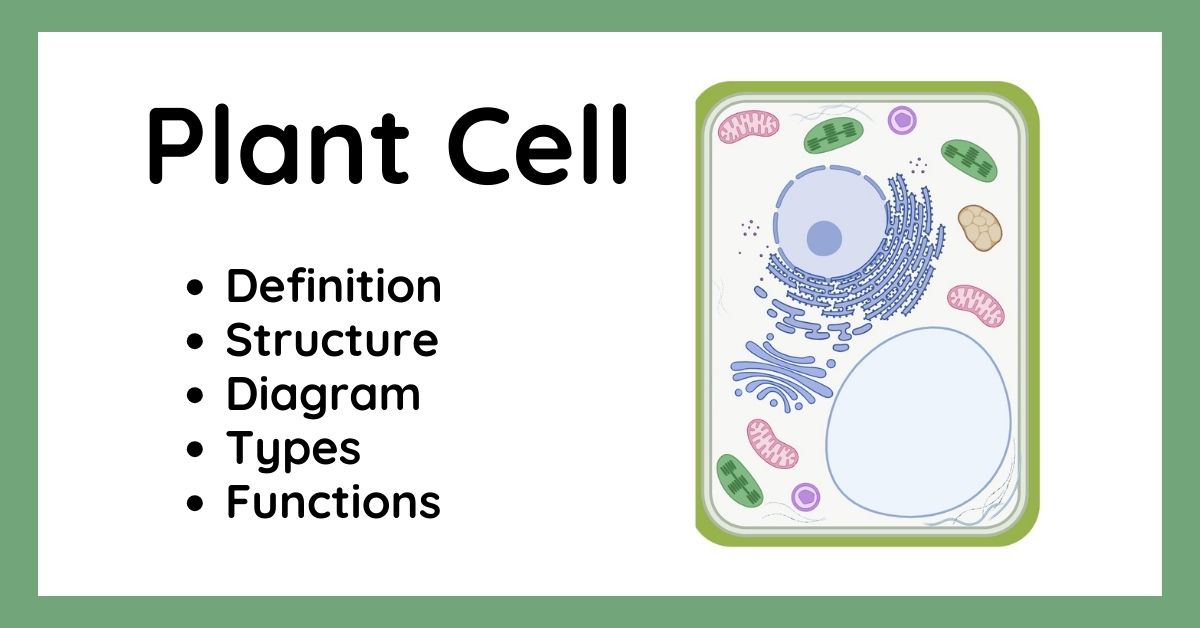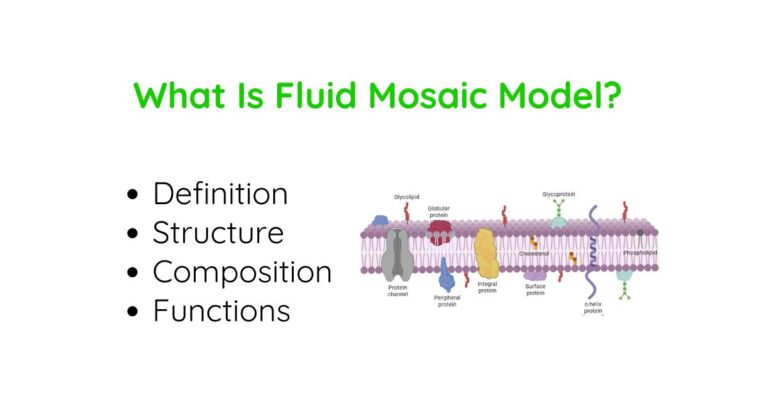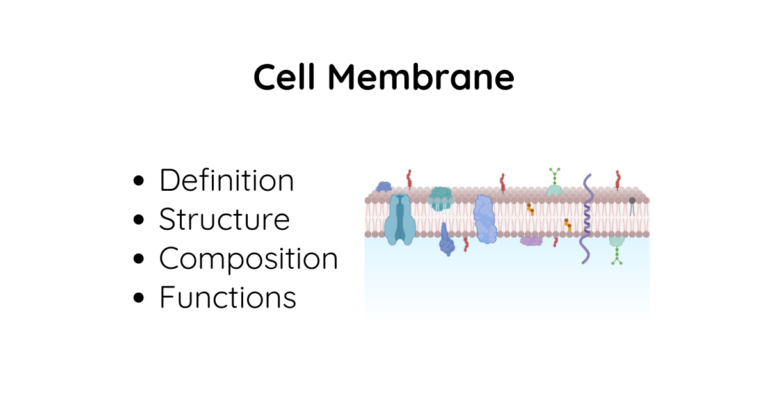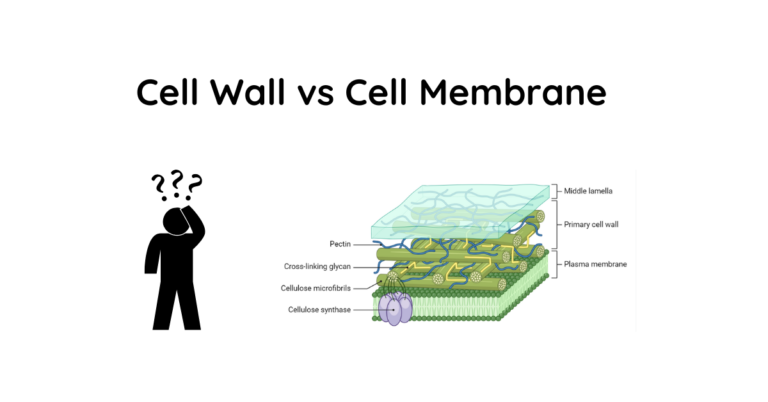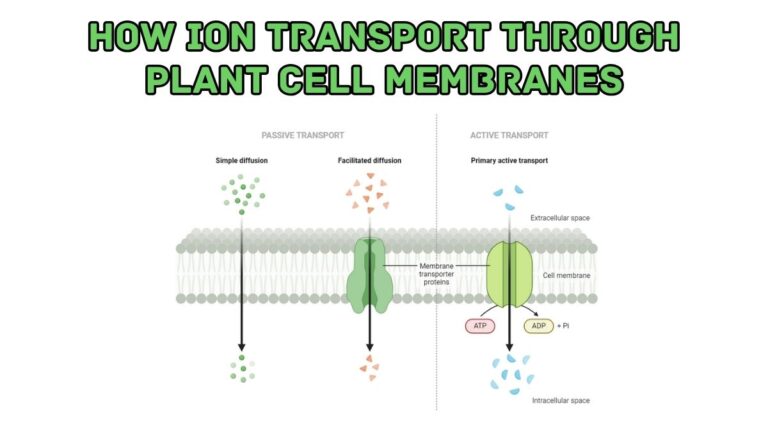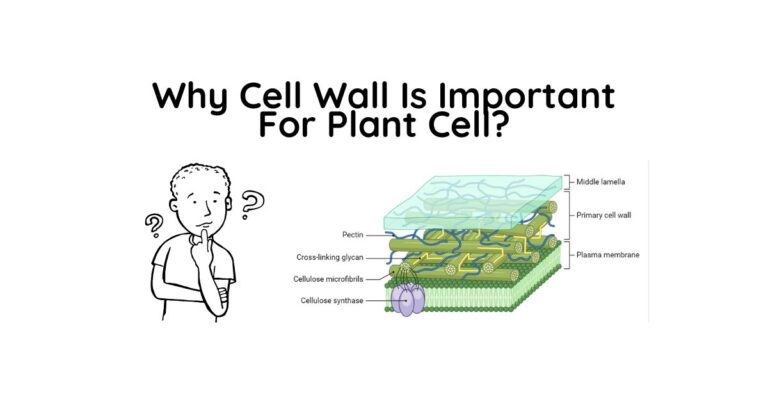Plant Cell – Definition, Structure, Types, Functions, and Important
Hey, welcome to the world of plant cells.
In this article, I will share academic and recent scientific knowledge about plant cells.
This includes:
- Definition
- Structure
- Functions
- Types
- and more
So let’s deep dive!
What Is Plant Cell?
A plant cell is the fundamental, structural, and functional unit of plants. It is a eukaryotic cell, meaning it has a true nucleus enclosed within a membrane. Plant cells are distinct from animal cells and other eukaryotic cells in several ways.
Plant Cell Definition
A plant cell can be defined as a eukaryotic cell that is surrounded by a cell wall made of cellulose and has specialized organelles like chloroplasts, which are involved in photosynthesis.
Plant Cell Structure
The structure of a plant cell is complex and highly organized. It consists of several components, each with a specific function. Here are the main parts of a plant cell:
Cell Wall
The cell wall is a rigid, protective layer surrounding the plant cell membrane. It serves as an exoskeleton, providing structural support and shape to the plant cell. The primary components of the cell wall are:
- Cellulose: A complex carbohydrate that forms long, unbranched chains, giving the cell wall its strength and rigidity.
- Hemicellulose: A group of shorter, branched polysaccharides that help bind the cellulose fibers together.
- Pectin: A complex carbohydrate that acts as a cementing material, helping to hold the cell wall components together.
The cell wall also allows for the controlled movement of water, nutrients, and other substances into and out of the cell.
Cell Membrane
The cell membrane, also known as the plasma membrane, is a selectively permeable barrier that surrounds the cytoplasm of a cell. It regulates the movement of substances in and out of the cell, maintaining the cell’s internal environment.
The cell membrane is composed of:
- Phospholipids: These form a double layer, providing the basic structure of the membrane.
- Proteins: Embedded in the phospholipid bilayer, proteins serve various functions, such as transport channels, receptors, and enzymes.
- Carbohydrates: Attached to some proteins, carbohydrates help in cell recognition and adhesion.
Nucleus
The nucleus is a membrane-bound organelle that houses the genetic material (DNA) of the cell. It is often referred to as the “control center” of the cell because it regulates many cellular activities.
The main components of the nucleus are:
- Nuclear Envelope: A double membrane that surrounds the nucleus and separates it from the cytoplasm.
- Nucleolus: A dense region within the nucleus where ribosomal RNA (rRNA) is synthesized and assembled with proteins to form ribosomes.
- Chromatin: The complex of DNA and proteins that condenses into chromosomes during cell division.
The nucleus plays a crucial role in gene expression, protein synthesis, and cell division, as it contains the instructions necessary for the cell’s functioning and reproduction.
Cytoplasm
The cytoplasm is the jelly-like substance that fills the space between the cell membrane and the nucleus.
The cytoplasm provides an environment for various cellular processes, such as metabolism, protein synthesis, and transport of materials.
It also serves as a medium for the movement and anchoring of organelles.
There are several elements of cytoplasm:
- Cytosol: The liquid portion of the cytoplasm, which is a mixture of water, salts, and various organic molecules.
- Organelles: Membrane-bound structures suspended in the cytoplasm, each with specific functions.
Chloroplasts
Chloroplasts are green, disc-shaped organelles found in plant cells and some algae. They are responsible for the process of photosynthesis, which converts light energy from the sun into chemical energy in the form of glucose.
Chloroplasts are essential for the survival of plants and play a vital role in the global carbon cycle and oxygen production.
Chloroplasts contain:
- Thylakoid System: A system of flattened membrane sacs called thylakoids, where the light-dependent reactions of photosynthesis occur.
- Stroma: The fluid-filled space surrounding the thylakoid system, where the light-independent reactions of photosynthesis take place.
- Chlorophyll: A green pigment that absorbs sunlight, initiating the photosynthetic process.
Mitochondria
Mitochondria are often referred to as the “powerhouses” of the cell because they produce energy in the form of ATP (adenosine triphosphate) through cellular respiration.
Mitochondria are found in nearly all eukaryotic cells and play a crucial role in energy production, allowing cells to carry out various metabolic processes.
The main components of mitochondria are:
- Outer Membrane: The outer membrane separates the mitochondrion from the cytoplasm.
- Inner Membrane: The inner membrane is highly folded, forming projections called cristae, which increase the surface area for the enzymes involved in ATP production.
- Matrix: The inner space of the mitochondrion, where the enzymes for the Krebs cycle and other biochemical reactions are located.
Vacuole
Plant cells typically have one or more large vacuoles that occupy a significant portion of the cell volume.
Vacuoles are membrane-bound organelles that perform various functions, including:
- Storage: Vacuoles store water, nutrients, waste products, and other materials essential for the plant’s growth and development.
- Maintaining Turgor Pressure: The accumulation of water and dissolved substances in the vacuole creates turgor pressure, which helps maintain the plant’s rigidity and shape.
- Waste Disposal: Vacuoles can accumulate and isolate toxic substances and waste products, protecting the cell from damage.
Endoplasmic Reticulum (ER)
The endoplasmic reticulum (ER) is a network of membranous tubules and sacs that extend throughout the cytoplasm.
It is involved in various cellular processes, such as:
- Protein Synthesis: Ribosomes attached to the rough ER synthesize proteins that are then transported and modified within the ER.
- Lipid Synthesis: The smooth ER is involved in the production of lipids, such as phospholipids and steroids.
- Detoxification: The smooth ER also plays a role in metabolizing and detoxifying certain substances.
- Transport: The ER serves as a highway for the movement of proteins, lipids, and other materials throughout the cell.
Golgi Apparatus
The Golgi apparatus is a stack of flattened membrane sacs that plays a crucial role in the modification, sorting, and packaging of proteins and other materials within the cell.
Its main functions include:
- Modification: The Golgi apparatus modifies proteins and lipids by adding or removing chemical groups, such as sugars or phosphates.
- Sorting: It sorts and packages proteins and other materials into membrane-bound vesicles for transport to their final destinations within or outside the cell.
- Secretion: The Golgi apparatus is responsible for the secretion of certain substances, such as enzymes, hormones, and cellular components, by releasing vesicles that fuse with the cell membrane.
Ribosomes
Ribosomes are small, non-membrane-bound organelles composed of RNA and proteins. They are responsible for protein synthesis, which is a fundamental process in all living cells.
Ribosomes consist of two subunits:
- Small Subunit: Consists of a small ribosomal RNA (rRNA) and several proteins.
- Large Subunit: Consists of a large rRNA and numerous proteins.
During protein synthesis, ribosomes read the genetic instructions encoded in messenger RNA (mRNA) and translate them into specific sequences of amino acids, which are then assembled into functional proteins.
Ribosomes can be found in two locations within the cell:
- Free Ribosomes: These are found in the cytoplasm and synthesize proteins that remain within the cytosol or are destined for organelles like mitochondria or chloroplasts.
- Bound Ribosomes: These ribosomes are attached to the rough endoplasmic reticulum (ER) and synthesize proteins that are destined for secretion or insertion into the ER membrane or other cellular membranes.
Plant Cell Diagram
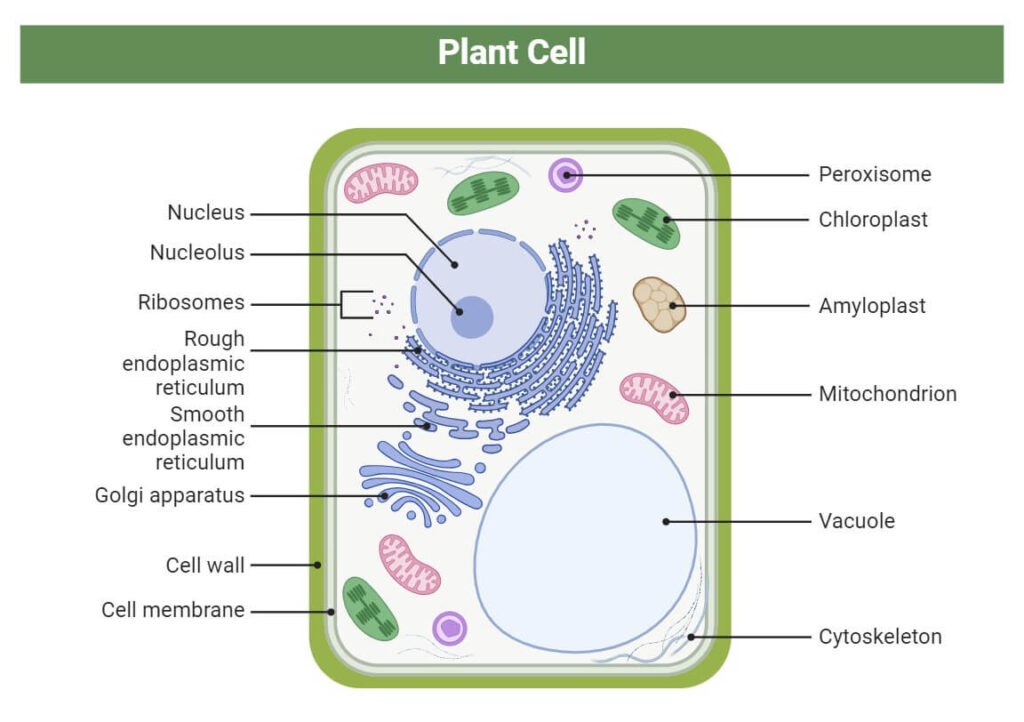
This diagram illustrates the various organelles and components of a typical plant cell, including the cell wall, cell membrane, nucleus, chloroplasts, mitochondria, vacuole, endoplasmic reticulum, Golgi apparatus, and ribosomes.
Plant Cell Under Microscope
Plant cells can be observed under a microscope, revealing their complex structures and organelles. The cell wall, chloroplasts, and vacuoles are easily visible, and the movement of cytoplasmic streaming can often be observed.
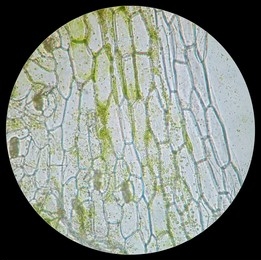
What Are The Different Types Of Plant Cells?
Plants are made up of various specialized cells that perform distinct functions. The main types of plant cells are:
Parenchyma Cells
- Thin-walled, living cells with a prominent nucleus and protoplasm
- Polyhedral, oval, round or elongated in shape
- Loosely or tightly packed with small intercellular spaces
- Cell walls made of cellulose, hemicellulose, and calcium pectate
- Contain chloroplasts, vacuoles, ribosomes, ER, and Golgi bodies
- Functions include photosynthesis, storage, secretion, repair, and transport.
Collenchyma Cells
- Elongated living cells with irregularly thickened primary cell walls
- Cell walls unevenly thickened at corners where cells join
- Composed of cellulose, pectin, and can expand by absorbing water
- Provide structural support and flexibility to growing plant parts
- Found in strands or cylinders in cortex of stems, leaf veins, etc
Sclerenchyma Cells
- Dead cells with thick, lignified secondary cell walls
- Rigid and non-stretchable, providing structural strength
- Two main types: fibers (long, tapering ends) and sclereids (variable shapes)
- Fibers found in stems, roots, vascular bundles; sclereids in seed coats, nutshel
Xylem Cells
- Part of vascular tissue, transporting water and minerals
- Include tracheids, vessel elements (for conduction), and fibers (support)
- Have lignified walls with perforations/pits to facilitate water flow
- Arranged end-to-end forming continuous hollow tubes
Phloem Cells
- Part of vascular tissue, transporting food materials like sucrose
- Include sieve tube members (for conduction), companion cells, and fibers
- Sieve tube members have perforated end walls for food transport
- Companion cells assist in loading/unloading nutrients
Tracheids and Vessel Elements
- Specialized conducting cells in the xylem tissue
- Tracheids are elongated, tapering cells with lignified secondary walls
- Vessel elements are stacked to form continuous tubes for water and mineral transport
Sieve Tube Elements
- Specialized conducting cells in the phloem tissue
- Arranged end-to-end, forming sieve tubes for transporting organic nutrients
- Companion cells provide metabolic support
Guard Cells
- Paired specialized cells surrounding the stomata (pores) on leaf surfaces
- Control the opening and closing of stomata for gas exchange and transpiration
Root Hair Cells
- Elongated, tubular outgrowths from epidermal cells in the root
- Increase the surface area for water and mineral absorption from the soil
Transfer Cells
- Specialized parenchyma cells with wall ingrowths
- Found at sites of nutrient transfer, e.g., seed coats, nectaries
- Wall ingrowths increase surface area for efficient transport
Plant Cell Functions
Photosynthesis
Chloroplasts in plant cells carry out photosynthesis, converting light energy into chemical energy in the form of glucose.
During photosynthesis, chloroplasts use the energy from sunlight, carbon dioxide (CO2) from the air, and water from the roots to produce glucose (C6H12O6) and oxygen (O2) as a byproduct.
The glucose produced is a vital source of energy for the plant and is used in various metabolic processes, including cellular respiration and the synthesis of other organic compounds.
Cellular Respiration
Mitochondria in plant cells produce energy in the form of ATP through cellular respiration, which is essential for various cellular processes.
Cellular respiration is the process by which energy is released from organic molecules, such as glucose, through a series of chemical reactions.
Mitochondria break down glucose in the presence of oxygen, producing ATP (adenosine triphosphate), which is the primary energy currency of the cell.
Storage
The large central vacuole in plant cells is a membrane-bound organelle that can occupy up to 90% of the cell’s volume. The vacuole serves as a storage compartment for water, nutrients (e.g., amino acids, sugars, and minerals), pigments, waste products, and other molecules.
By storing water, the vacuole helps maintain the plant cell’s turgidity, which is essential for structural support and growth.
Structural Support
The rigid cell wall provides structural support and protection to the plant cell. It helps maintain the shape of the plant cell and prevents it from bursting due to high internal pressure (turgidity).
It also acts as a barrier against pathogens and mechanical stress, contributing to the overall structural integrity of the plant.
Transport
Plant cells are involved in the transport of water, minerals, and nutrients through specialized cells like sieve-tube members and tracheids.
Specialized cells, such as sieve-tube members (phloem cells), transport organic nutrients like sucrose from sources (leaves) to sinks (roots, fruits, or growing regions).
Tracheids and vessel elements (xylem cells) are responsible for the transport of water and minerals from the roots to the leaves and other parts of the plant.
The movement of these substances occurs through various mechanisms, including diffusion, osmosis, and active transport, facilitated by specialized membrane proteins and ion channels.
Growth and Development
Plant cells undergo cell division and differentiation to form various tissues and organs, enabling the growth and development of the plant.
The process of cell division is regulated by the cell cycle, which is controlled by specific genes and signaling pathways.
After division, plant cells can differentiate into specialized cell types, such as root cells, stem cells, leaf cells, or reproductive cells, forming various tissues and organs.
This differentiation is governed by gene expression patterns and hormonal signals, allowing the plant to develop its characteristic structures and perform specific functions.
Cell-to-Cell Communication
Plant cells are interconnected through specialized channels called plasmodesmata, which facilitate the movement of molecules, including proteins, RNA, and small metabolites, between adjacent cells.
This cell-to-cell communication is essential for coordinating various physiological processes, such as growth, development, and responses to environmental stimuli, throughout the plant.
Defense Mechanisms
Plant cells have evolved defense mechanisms to protect themselves against pathogens, herbivores, and environmental stresses.
These mechanisms include the production of defensive compounds (e.g., phenolic compounds, alkaloids, and enzymes), the reinforcement of cell walls, and the activation of specific signaling pathways that trigger local and systemic responses.
Reproduction
In addition to vegetative growth, plant cells are involved in the reproductive processes of plants.
Specialized reproductive cells, such as egg cells and sperm cells, are formed through meiosis, enabling sexual reproduction and genetic recombination.
Other specialized cells, like those in the ovule and pollen, play crucial roles in the development of seeds and the propagation of the plant species.
Environmental Responses
Plant cells can sense and respond to various environmental cues, such as light, temperature, water availability, and nutrient levels.
These responses involve complex signaling pathways and changes in gene expression, allowing plants to adapt to their environment and optimize their growth and development.
Why Plant Cells Are Important?
- Photosynthesis: Chloroplasts in plant cells enable photosynthesis, which is the process of converting light energy into chemical energy in the form of glucose. This process is crucial for sustaining life on Earth.
- Oxygen Production: During photosynthesis, plant cells release oxygen as a byproduct, which is essential for the survival of aerobic organisms, including humans.
- Food Production: Plants are the primary producers in most food chains, providing food for humans and other organisms.
- Structural Support: The rigid cell walls of plant cells provide structural support, enabling plants to grow upright and withstand environmental stresses.
- Environmental Benefits: Plants play a vital role in maintaining the balance of gases in the atmosphere, preventing soil erosion, and providing habitats for various organisms.
How Does A Plant Cell Look Like?
Plant cells have a distinct rectangular or cylindrical shape due to their rigid cell walls. They are typically larger than animal cells and can be observed as green, rectangular structures under a microscope, especially in leaf and stem tissues, where chloroplasts are abundant.
What Are The Different Organelles Found In Plant Cells
The main organelles found in plant cells are:
- Cell Wall
- Cell Membrane
- Nucleus
- Cytoplasm
- Chloroplasts
- Mitochondria
- Vacuole
- Endoplasmic Reticulum (ER)
- Golgi Apparatus
- Ribosomes
FAQs
Which Organelle Is Unique To Plant Cells And Its Function?
The organelle unique to plant cells is the chloroplast. Chloroplasts are green, disc-shaped organelles that contain chlorophyll and are responsible for photosynthesis, the process of converting light energy into chemical energy in the form of glucose.
What Are The Similarities Between Plant And Animal Cells?
Plant and animal cells share several similarities as they are both eukaryotic cells. Some common features such as the presence of a nucleus, membrane-bound organelles like mitochondria, endoplasmic reticulum, and Golgi apparatus.
Are Lysosomes In Plant Cells?
No, plant cells do not have lysosomes, which are membrane-bound organelles found in animal cells that contain digestive enzymes. However, plant cells have vacuoles that perform some functions similar to lysosomes, such as storing and breaking down waste materials and digesting macromolecules.
Do All Plant Cells Have Chloroplast?
No, not all plant cells have chloroplasts. Chloroplasts are present in the cells of the photosynthetic tissues, such as leaves and green stems, where they carry out photosynthesis. However, non-photosynthetic cells, like those in roots, seeds, and some specialized cells, do not contain chloroplasts.
Do Plant Cells Have Ribosomes?
Yes, plant cells have ribosomes, which are organelles responsible for protein synthesis. Ribosomes can be found either freely suspended in the cytoplasm or attached to the endoplasmic reticulum (ER).
Do Plant Cells Have Chromosomes?
Yes, plant cells have chromosomes, which are structures within the nucleus that carry the genetic material (DNA). The number of chromosomes varies among different plant species.
Do Plant Cells Have Cytoplasm?
Yes, plant cells have cytoplasm, which is the jelly-like substance that fills the space between the cell membrane and the nucleus. The cytoplasm contains various organelles and is the site of many cellular processes.
Do Plant Cells Have Mitochondria?
Yes, plant cells have mitochondria, which are organelles responsible for producing energy in the form of ATP through cellular respiration. Mitochondria are often referred to as the “powerhouses” of the cell.
Do Plants Have Centrioles?
No, plant cells generally do not have centrioles, which are cylindrical structures found in animal cells and involved in the formation of spindle fibers during cell division. However, some lower plant species, such as algae and bryophytes, do have centrioles in their sperm cells.
Do Plant Cells Have A Nucleus?
Yes, plant cells have a nucleus, which is a membrane-bound organelle that contains the genetic material (DNA) and controls the cell’s activities. The nucleus is a characteristic feature of eukaryotic cells, including plant cells.
Are Plant Cells Alive?
Yes, plant cells are alive. They are the fundamental units of life in plants and possess all the characteristics of living organisms, such as metabolism, growth, reproduction, and the ability to respond to stimuli.
Which Plant Has the Longest Cell?
The plant with the longest cells is the marine green algae Valonia ventricosa, which can have cells up to several centimeters in length. These giant cells are visible to the naked eye and are often used in research studies due to their size.
Do All Plants Have Cells?
Yes, all plants are composed of cells. Plants are multicellular organisms, meaning they are made up of many cells that are organized into tissues, organs, and systems. Even the simplest plants, such as algae, are composed of one or more cells.
Do Cells Contain DNA?
Yes, both plant and animal cells contain DNA (deoxyribonucleic acid), which is the genetic material that carries the instructions for the development, functioning, and reproduction of living organisms. In eukaryotic cells, like plant cells, the DNA is located within the nucleus.
What Are The Small Dots In A Plant Cell?
The small dots observed in plant cells under a microscope are likely ribosomes. Ribosomes are tiny organelles composed of RNA and proteins, and they are responsible for protein synthesis. They can be found either freely suspended in the cytoplasm or attached to the endoplasmic reticulum (ER).
References:
- Zeng, M., Mosier, N. S., Huang, C. P., Sherman, D. M., & Ladisch, M. R. (2007). Microscopic examination of changes of plant cell structure in corn stover due to hot water pretreatment and enzymatic hydrolysis. Biotechnology and bioengineering, 97(2), 265-278.
- Crang, R., Lyons-Sobaski, S., Wise, R., Crang, R., Lyons-Sobaski, S., & Wise, R. (2018). Plant cell structure and ultrastructure. Plant Anatomy: A Concept-Based Approach to the Structure of Seed Plants, 77-121.
- Showalter, A. M. (1993). Structure and function of plant cell wall proteins. The plant cell, 5(1), 9.
- O’Neill, M. A., & York, W. S. (2018). The composition and structure of plant primary cell walls. Annual Plant Reviews online, 1-54.
- Hall, J.L., Flowers, T.J., & Roberts, R.M. (1974). Plant cell structure and metabolism.

